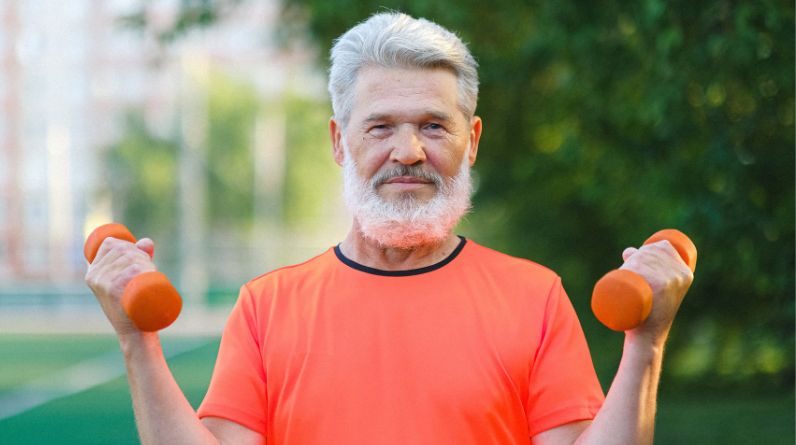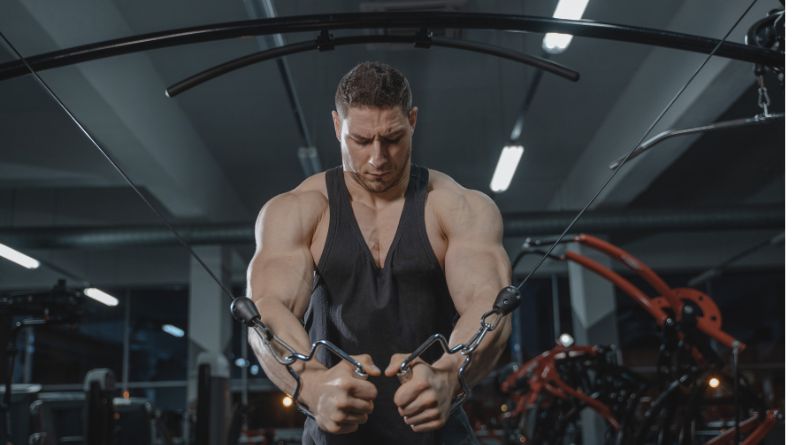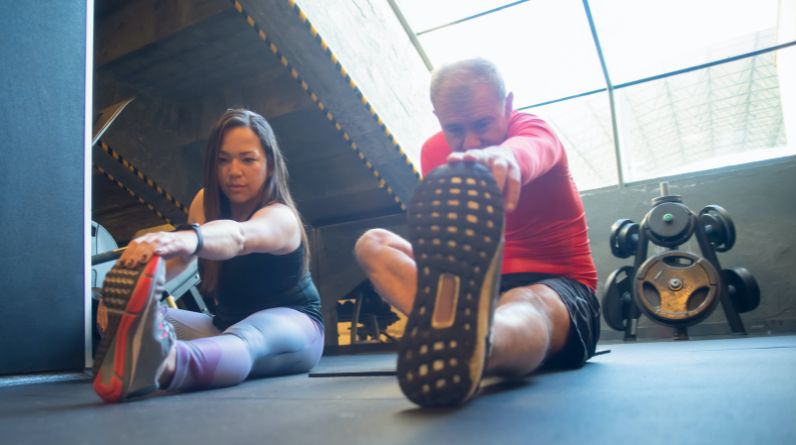
Introduction
They say age is just a number, but when it comes to muscle building, that number can sometimes throw a curveball. Let’s face it; our bodies transform as we age. But does this mean our muscle-building dreams should retire? Not a chance! In this guide, we’ll unlock the secrets of aging and muscle building, along with strategies to keep you flexing those muscles well into your golden years.
The Age-Old Question: How Does Muscle Building Change as We Age?
As you blow out more and more candles on your birthday cake, your muscle-building journey takes on a unique character. Here’s how:
1. A Slower Metabolism: With each passing year, your metabolism tends to slow down. This means your body burns fewer calories, which can make it easier to gain weight. And not the muscular kind.
2. Muscle Mass Decline: From your 30s onward, you start losing muscle mass. This process, called sarcopenia, can reduce muscle strength and functional abilities.
3. Decreased Testosterone: Testosterone, the muscle-friendly hormone, tends to decline as you age. This drop can affect muscle growth and energy levels.
4. Longer Recovery Times: As you age, your muscles might take longer to recover after workouts. Those pesky muscle soreness days after hitting the gym? They might stick around longer.
But don’t fret! While these age-related changes are inevitable, there are strategies that can help you defy the laws of aging and maintain that muscle-packed physique.
Strategies for Maintaining Muscle Mass Later in Life
1. Weight Training for the Win:
Age might be creeping up, but your muscles don’t have to surrender to it. Weight training, also known as resistance training, becomes even more critical as you age. Here’s why it’s your best friend:
- Challenge for Growth: Lifting weights puts your muscles through a delightful struggle. It creates micro-tears in your muscle fibers that your body then rebuilds stronger and larger. This process is how you promote muscle growth even when you’re older.
- Counteracting Muscle Loss: Age-related muscle loss, or sarcopenia, can affect your strength and functional abilities. Weight training directly combats this loss. It helps maintain muscle mass and function, keeping you physically capable and independent as you age.
- Metabolism Boost: Muscle burns more calories than fat. So, the more muscle you have, the higher your metabolism. This can help prevent age-related weight gain and keep your energy levels up.
But remember, when you’re lifting weights, it’s not about trying to break any records or show off at the gym. Focus on proper form, and don’t overdo it. Your muscles might not recover as quickly as they used to, so listen to your body and don’t push it too hard.
2. Protein Power:
Protein is the unsung hero of the aging muscle-building saga. As you get older, your body becomes less efficient at using dietary protein for muscle maintenance and growth. Here’s how protein comes to your rescue:
- Maintenance and Growth: Protein provides the building blocks your body needs to repair and build muscle tissue. In fact, it’s vital for muscle maintenance and growth at any age, but it becomes especially crucial as you get older and muscle loss becomes a concern.
- Optimal Recovery: When you’re doing resistance training, your muscles require extra protein for recovery. Without it, your muscles might not rebuild effectively, and you might experience more prolonged muscle soreness.
- Aging Digestive Efficiency: With age, your digestive system might not absorb nutrients as efficiently as it used to. This can lead to reduced protein absorption. To counteract this, consider increasing your protein intake or choosing high-quality protein sources.
- Sources: Aim for a protein-rich diet. You can find protein in lean meats, poultry, fish, eggs, dairy products, legumes, and plant-based sources like tofu and tempeh. If it’s challenging to meet your protein needs through food alone, consider protein supplements like protein shakes.
3. Balanced Nutrition:
Building and maintaining muscle is not just about protein. A balanced diet provides your body with all the essential nutrients it needs to stay in tip-top shape, both for muscle health and overall well-being. Here’s what it involves:
- Vitamins and Minerals: A balanced diet ensures you get all the vitamins and minerals necessary for muscle function and overall health. For instance, vitamin D and calcium support muscle contractions and bone health, while magnesium aids muscle relaxation.
- Carbohydrates for Energy: Don’t forget carbohydrates. They’re your body’s primary energy source, especially during exercise. Opt for complex carbohydrates found in whole grains, fruits, and vegetables. They provide a steady energy supply and support your workouts.
- Healthy Fats: Include healthy fats like those found in avocados, nuts, seeds, and fatty fish. These fats are essential for hormone production and overall well-being. They provide an additional energy source to help fuel your workouts.
- Hydration: Proper hydration is often underestimated. Water is vital for muscle function. It aids muscle contractions, prevents cramps, and helps your body cool down during exercise. Even mild dehydration can impair physical performance.
A balanced diet is like your muscle’s best friend, providing the support they need to stay in top shape. Remember, no single nutrient can do the job alone. It’s the synergy between all the essential nutrients that keeps your muscles flexing strong.
4. Hydration Matters:
Water may not seem directly connected to building muscle, but it’s an indispensable part of the process, especially as you age:
- Muscle Contractions: Your muscles rely on proper hydration to contract effectively. Dehydration can lead to muscle cramps and reduced exercise performance.
- Temperature Regulation: When you’re working out, your body heats up. Water helps regulate your temperature, preventing overheating. Overheating can lead to muscle fatigue and discomfort.
- Joint Lubrication: Staying hydrated supports the lubrication of your joints. Well-lubricated joints reduce the risk of injury, especially as you age and joint health becomes a priority.
- Recovery: After a workout, adequate hydration supports your body’s recovery. It helps flush out waste products generated during exercise, reducing muscle soreness.
So, remember to drink enough water before, during, and after your workouts. Your muscles and overall well-being will thank you.
5. Adequate Rest and Recovery:
In your younger years, you might have been able to bounce back from workouts more quickly. But as you age, your muscles might need a bit more TLC. Here’s why adequate rest and recovery are essential:
- Longer Recovery Times: Aging muscles can take longer to repair after workouts. They’re more prone to micro-tears, which can lead to delayed-onset muscle soreness (DOMS). Sufficient rest helps speed up this recovery process.
- Quality Sleep: Muscle recovery and growth happen primarily during sleep. So, if you’re short on sleep, you might miss out on a significant part of the muscle-building process. Aim for 7-9 hours of quality sleep per night.
- Preventing Overtraining: As you age, your risk of overtraining and overuse injuries increases. Adequate rest between workouts helps prevent overtraining, ensuring your muscles can repair and grow without being overtaxed.
So, don’t rush back to the gym without giving your muscles time to recuperate. Rest is not a sign of weakness but an essential component of muscle building, especially as you age.
6. Flexibility and Mobility:
Flexibility and mobility exercises should become your lifelong companions. They’re not just for yogis and contortionists; they play a vital role in maintaining muscle health:
- Preventing Muscle Stiffness: As you age, muscles tend to get stiffer. Stretching exercises can counteract this stiffness, keeping your muscles flexible and ready for action.
- Range of Motion: Improved flexibility can enhance your range of motion, making it easier to perform daily activities. This is especially important as you age to maintain independence and functional fitness.
- Injury Prevention: Stretching and mobility exercises can reduce the risk of muscle strains and joint injuries. They help keep your muscles and joints in good working order, reducing the chances of painful injuries.
- Post-Workout Recovery: Post-workout stretching helps relax your muscles and reduce muscle soreness. This means you can recover more quickly and get back to your workouts with minimal discomfort.
Don’t underestimate the power of flexibility exercises. They’re not just for yoga studios. Incorporate stretching and mobility into your regular routine to keep your muscles supple and injury-free.
7. Consistency is King:
In the world of muscle building, consistency reigns supreme, especially as you age. Here’s why it’s your secret weapon:
- Slow and Steady Wins: Muscle building, like many good things in life, takes time. Consistency allows you to gradually and safely build muscle without risking injury or setbacks.
- Maintaining Progress: Consistency helps you maintain your muscle-building progress. Irregular workouts can lead to muscle atrophy, where your hard-earned gains slowly disappear.
- Habit Formation: Consistency fosters habit formation. The more consistent you are with your workouts and nutrition, the more likely these healthy practices become part of your daily life.
- Mindset Reinforcement: Consistency reinforces a positive mindset. It’s a tangible way to demonstrate your commitment to your muscle-building goals, which can boost your motivation.
So, set a schedule, stick to it, and watch your muscles respond with steady and reliable progress.
8. Consult a Pro:
Not everyone is born with an innate knowledge of muscle building, and that’s perfectly fine. Seeking the guidance of a fitness or healthcare professional is a wise move, especially if:
- You’re new to muscle building and don’t know where to start.
- You have underlying health conditions that require a tailored approach.
- You’re dealing with injuries or physical limitations.
A professional can design a personalized plan that addresses your unique needs and goals. It’s a smart investment in your muscle-building journey.
9. Manage Stress:
Stress, whether from daily life or intense workouts, can lead to muscle loss. Here’s how managing stress can make a significant difference:
- Hormone Balance: High stress levels can disrupt hormone balance, including the cortisol hormone, which can lead to muscle breakdown. Managing stress can help maintain a healthy hormonal environment for muscle growth.
- Improved Recovery: Stress management techniques like meditation and deep breathing can help your muscles recover more efficiently. Less stress equals faster recovery and less muscle soreness.
- Mood and Motivation: Managing stress keeps your mood positive and your motivation high. This translates to more effective workouts and consistent muscle-building progress.
So, consider adding stress management techniques to your daily routine. Your muscles and your overall well-being will thank you.
10. Stay Positive:
Last but not least, keep a positive mindset. Believe in your ability to defy age and keep your muscles going strong. Here’s why it’s your ultimate armor:
- Motivation Booster: A positive mindset keeps you motivated to stick to your workout and nutrition plans. It reminds you that age is just a number, and your body is capable of incredible feats.
- Stress Buster: Positivity reduces stress, which is excellent for muscle health. A relaxed body and mind support muscle growth and overall well-being.
- Enjoyment: Approaching your muscle-building journey with a positive outlook can make it more enjoyable. You’re more likely to stick with it when you’re having fun along the way.
Remember, building and maintaining muscle at any age is not just about the physical effort; it’s also about the mental attitude you bring to the table. Stay positive, believe in yourself, and watch your muscles flourish.
Frequently Asked Questions
Q1: Can I still build muscle after 50?
Absolutely! Age is not a barrier to building muscle. While it’s true that your body undergoes changes as you get older, including a natural decrease in muscle mass and bone density, it’s never too late to start working on muscle growth and strength. In fact, resistance training has been shown to be effective even in seniors. You might need to make some adjustments to your approach, but the potential for building muscle remains. Your body is adaptable and capable of remarkable changes, even after 50. So, don’t let age be a deterrent; embrace the challenge and start your muscle-building journey.
Q2: How often should I work out as I get older?
The frequency of your workouts can vary depending on your fitness level and goals, but here are some general guidelines for older adults:
- Strength Training: Aim for at least 2-3 days of strength training per week. This can include lifting weights, using resistance bands, or doing bodyweight exercises.
- Aerobic Activity: Strive for a minimum of 150 minutes of moderate-intensity aerobic activity per week. This can be broken down into shorter sessions, like 30 minutes a day for five days.
Remember, the key is to find a routine that suits your individual needs and abilities. You may need to start slowly and gradually increase your activity level. Don’t hesitate to consult a fitness professional or healthcare provider for a personalized exercise plan.
Q3: Is there an age where it’s too late to start building muscle?
No, there’s no specific age at which it’s “too late” to start building muscle. Your body is remarkably adaptable and responsive to the right exercise and nutrition. Even if you’re in your 60s, 70s, or beyond, you can still experience the benefits of muscle building. It might take a bit longer to achieve certain goals compared to when you were younger, but the improvements in strength, mobility, and overall well-being are well worth the effort.
Q4: Do I need supplements for muscle building as I age?
While supplements can be beneficial, they are not essential for muscle building, especially if you have a balanced diet. A diet rich in protein, healthy fats, and essential nutrients can provide most of what your body needs to support muscle growth and maintenance. Supplements like protein powders or branched-chain amino acids can be useful if you struggle to meet your nutritional needs through food alone. However, it’s always a good idea to consult with a healthcare professional or registered dietitian before starting any supplement regimen to ensure they’re safe and suitable for your specific requirements.
Q5: How do I prevent muscle soreness as I age?
Muscle soreness, also known as delayed-onset muscle soreness (DOMS), can be reduced with a few strategies:
- Warm-ups and Cool-Downs: Always start your workouts with a proper warm-up and end them with a cool-down. This helps prepare your muscles for exercise and aids in their recovery.
- Stretching: Incorporate stretching into your routine, especially after workouts. This helps alleviate muscle tightness and can reduce soreness.
- Gradual Progression: Increase the intensity of your workouts gradually. Overexertion can lead to more significant soreness, so take it one step at a time.
- Hydration: Staying well-hydrated can aid in muscle recovery and reduce soreness. Ensure you drink enough water throughout the day.
While some degree of muscle soreness is normal, especially if you’re starting a new exercise program, these strategies can help minimize its intensity and duration.
Q6: Can I regain the muscle I’ve lost due to aging?
Yes, it’s entirely possible to regain lost muscle, even if you’ve experienced age-related muscle loss. Your body has a remarkable capacity to adapt and rebuild muscle tissue. To regain muscle, consistency is key. Incorporate strength training exercises into your routine regularly. Focus on compound movements that work multiple muscle groups, and ensure you’re consuming adequate protein to support muscle recovery and growth. While it may take some time and effort, the improvements in muscle strength and mass can be significant.
Q7: Should I consult a doctor before starting a muscle-building program as I age?
Consulting a healthcare professional before embarking on a new exercise program, especially if you have underlying health conditions or concerns, is a wise step. Your doctor can provide guidance tailored to your specific needs, ensuring your safety and well-being as you work on building muscle. This is particularly important if you have medical conditions such as heart disease, diabetes, or joint issues. Your healthcare provider can offer recommendations and monitor your progress, making your muscle-building journey safe and effective.
Q8: What’s the best type of exercise for seniors to build muscle?
For seniors, low-impact exercises are often the best choice for building muscle without putting excessive stress on joints and bones. Some effective and gentle options include:
- Swimming: It’s a fantastic full-body workout that’s easy on the joints.
- Walking: Regular brisk walking can provide cardiovascular and muscular benefits.
- Resistance Bands: These bands offer a low-impact way to perform strength-training exercises.
- Bodyweight Exercises: Moves like squats, lunges, and modified push-ups can help build muscle without high impact.
The best exercise for you depends on your current fitness level, any underlying health conditions, and your personal preferences. It’s advisable to consult a fitness professional or physical therapist to create a tailored exercise plan.
Q9: How long does it take to see results when building muscle later in life?
The timeline for seeing results in muscle building can vary significantly from person to person. It depends on factors such as your starting point, the intensity and consistency of your workouts, and your nutrition. With consistent effort, you can generally expect to notice improvements in muscle strength, endurance, and mobility within a few months. However, substantial muscle gains may take longer, often several months to a year or more. The key is to stay dedicated and patient, as progress might be gradual but is certainly achievable.
Q10: Can muscle building help with age-related issues like osteoporosis?
Yes, muscle-building exercises can be highly beneficial in addressing age-related issues such as osteoporosis. Strength training, in particular, has been shown to improve bone density, reducing the risk of fractures associated with osteoporosis. Building muscle also contributes to better balance, which can help prevent falls that often lead to fractures in older adults. Furthermore, resistance training can enhance overall functional fitness, making daily activities more manageable and enjoyable. It’s essential to include strength-training exercises as part of your fitness routine to help mitigate age-related concerns like osteoporosis. However, if you have specific health conditions, it’s advisable to consult your healthcare provider or a physical therapist for a program tailored to your needs.





